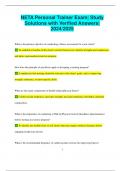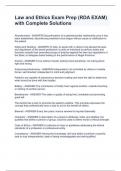NETA Personal Trainer Exam| Study
Solutions with Verified Answers|
2024/2025
What is the primary objective of conducting a fitness assessment for a new client?
To establish a baseline of the client’s current fitness level, identify strengths and weaknesses,
and tailor a personalized exercise program.
How does the principle of specificity apply to designing a training program?
It emphasizes that training should be relevant to the client's goals, such as improving
strength, endurance, or sport-specific skills.
What are the major components of health-related physical fitness?
Cardiovascular endurance, muscular strength, muscular endurance, flexibility, and body
composition.
What is the importance of conducting a PAR-Q (Physical Activity Readiness Questionnaire)
before starting an exercise program?
To identify any health issues or risk factors that may require medical clearance before
engaging in physical activity.
What is the recommended frequency of cardiovascular exercise for improving fitness?
1
, At least 150 minutes of moderate-intensity or 75 minutes of vigorous-intensity exercise per
week, spread across multiple days.
How can a personal trainer assess a client’s body composition?
By using methods such as skinfold measurements, bioelectrical impedance analysis, or dual-
energy X-ray absorptiometry (DEXA).
What is the difference between absolute and relative strength?
Absolute strength refers to the maximum amount of force a person can exert regardless of
body weight, while relative strength refers to the amount of force exerted relative to body
weight.
How does resistance training benefit bone health?
It stimulates bone remodeling and increases bone density, reducing the risk of osteoporosis.
What is the primary focus of the warm-up before exercise?
To prepare the body for physical activity by increasing heart rate, blood flow to muscles, and
joint mobility.
How can a personal trainer determine a client's target heart rate for aerobic exercise?
By calculating the maximum heart rate (220 minus the client's age) and determining the
target range (typically 50-85% of HRmax).
2
,What are the benefits of incorporating flexibility training into a fitness program?
It improves range of motion, reduces the risk of injury, and helps with post-exercise
recovery.
What is the role of stabilizer muscles during compound exercises like squats or deadlifts?
Stabilizer muscles help maintain posture and proper alignment, supporting the primary
muscles during the movement.
How does the principle of progression apply to a strength training program?
It involves gradually increasing the demands on the body over time, such as resistance, sets,
or repetitions, to promote adaptation and improvement.
What is the importance of proper hydration during exercise?
It maintains performance, regulates body temperature, and prevents dehydration-related
fatigue and impairment.
What is the ideal repetition range for promoting muscular hypertrophy?
Generally, 6-12 repetitions per set at moderate to high intensity.
How should a personal trainer modify a program for a client with knee pain?
Focus on low-impact exercises, avoid movements that exacerbate pain, and include
strengthening and flexibility exercises for surrounding muscles.
3
, What is the role of carbohydrates in an athlete’s diet?
To provide energy, particularly during high-intensity and endurance activities.
What is the significance of recovery days in a training program?
Recovery days allow muscles to repair and grow, reduce the risk of overtraining, and
improve overall performance.
How does the use of the RPE (Rating of Perceived Exertion) scale help in monitoring exercise
intensity?
It allows clients to assess their own exertion levels, providing a subjective measure that can
guide adjustments in intensity.
What is the recommended duration for static stretching after a workout?
Each stretch should be held for 15-30 seconds, focusing on major muscle groups.
What are the common signs of overtraining that trainers should watch for?
Persistent fatigue, decreased performance, mood changes, irritability, and increased risk of
injuries.
What is the role of plyometric training in a fitness program?
To improve power and explosiveness by utilizing quick, high-intensity movements that
engage the stretch-shortening cycle.
4





